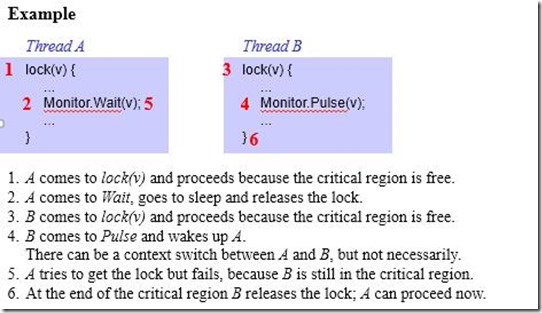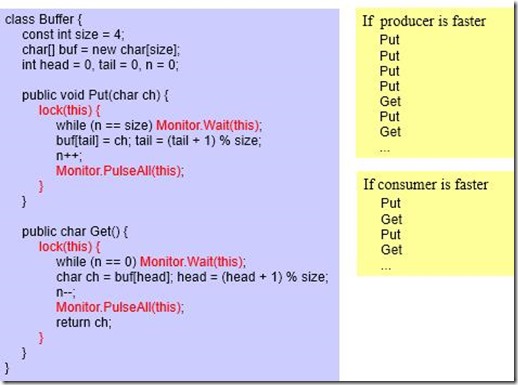C#復習⑧
2016年6月22日
13:50
Main Attribute & Threads 屬性與線程
1.Conditional Attribute 條件屬性
#define debug // preprocessor directive
class C {
[Conditional("debug")] // only possible for void methods
static void Assert (bool ok, string errorMsg) {
if (!ok) {
Console.WriteString(errorMsg);
System.Environment.Exit(0);
}
}
static void Main (string[] arg) {
Assert(arg.Length > 0, "no arguments specified");
Assert(arg[0] == "...", "invalid argument");
...
}
}
斷言僅被調用,如果定義了debug。
Assert is only called, if debug was defined.
還可用於控制跟蹤輸出。
Also useful for controlling trace output.
2.Serialization 序列化
3.AttributeUsage
4.線程
//假設有方法void M(){}
Thread t = new Thread(M);
t.Start(); //線程執行
5.Type類型
public sealed class Thread {
public static Thread CurrentThread { get; } // static properties and methods
public static void Sleep(int milliSeconds) {...}
...
public Thread(ThreadStart startMethod) {...} // thread creation
public string Name { get; set; } // properties
public ThreadPriority Priority { get; set; }
public ThreadState ThreadState { get; }
public bool IsAlive { get; }
public bool IsBackground { get; set; }
...
public void Start() {...} // methods
public void Suspend() {...}
public void Resume() {...}
public void Join() {...} // t.Join(): caller waits for t to die
public void Abort() {...} // throws ThreadAbortException
public void Interrupt() {...} // callable in WaitSleepState
...
}
public delegate void ThreadStart(); // parameterless void method
public enum ThreadPriority {Normal, AboveNormal, BelowNormal, Highest, Lowest}
public enum ThreadState {Unstarted, Running, Suspended, Stopped, Aborted, ...}
舉例:
using System;
using System.Threading;
class Printer {
char ch;
int sleepTime;
public Printer(char c, int t) {ch = c; sleepTime = t;}
public void Print() {
for (int i = 0; i < 100; i++) {
Console.Write(ch);
Thread.Sleep(sleepTime);
}
}
}
class Test {
static void Main() {
Printer a = new Printer('.', 10);
Printer b = new Printer('*', 100);
new Thread(a.Print).Start();
new Thread(b.Print).Start();
}
}
6.與Java的不同之處
7.線程的狀態以及相互轉化
using System;
using System.Threading;
class Test {
static void P() {
for (int i = 0; i < 20; i++) {
Console.Write('-');
Thread.Sleep(100);
}
}
static void Main() {
Thread t = new Thread(P);
Console.Write("start");
t.Start();
t.Join(); // waits until t has finished
Console.WriteLine("end");
}
}
//Output
// start--------------------end
using System; using System.Threading;
class Test {
static void P() {
try {
try {
try {
while (true) ;
} catch (ThreadAbortException) { Console.WriteLine("-- inner aborted"); }
} catch (ThreadAbortException) { Console.WriteLine("-- outer aborted"); }
} finally { Console.WriteLine("-- finally"); }
}
static void Main(string[] arg) {
Thread t = new Thread(P);
t.Start(); Thread.Sleep(0);
t.Abort(); t.Join(); Console.WriteLine("done");
}
}
/*Output
-- inner aborted
-- outer aborted
-- finally
done*/
8.互斥Mutual Exclusion
一次只能有一個線程掌握著該鎖。直到該鎖被釋放才能被其他線程調用。
舉例:
class Account { // this class is a monitor
long val = 0;
public void Deposit(long x) {
lock (this) { val += x; } // only 1 thread at a time may execute this statement
}
public void Withdraw(long x) {
lock (this) { val -= x; }
}
}
鎖可以加在任何類型上:
object semaphore = new object();
...
lock (semaphore) { ... critical region ... }
9.Wait and Pulse
Monitor.Wait(lockedVar); // 大致等於wait() in Java (in Java lockedVar is always this) Monitor.Pulse(lockedVar); //大致等於 notify() in Java Monitor.PulseAll(lockedVar); // 大致等於 notifyAll() in Java
舉例:

PulseAll(v)喚醒所有等待的線程的V,但其中只有一個是允許繼續。其他線程必須等待,直到前一個釋放了鎖。然後,下一個線程可能進入執行。
PulseAll(v) wakes up all threads that wait for v, but only one of them is allowed to continue. The others must wait until the previous one has released the lock. Then the next thread may enter the critical region.
舉例:
